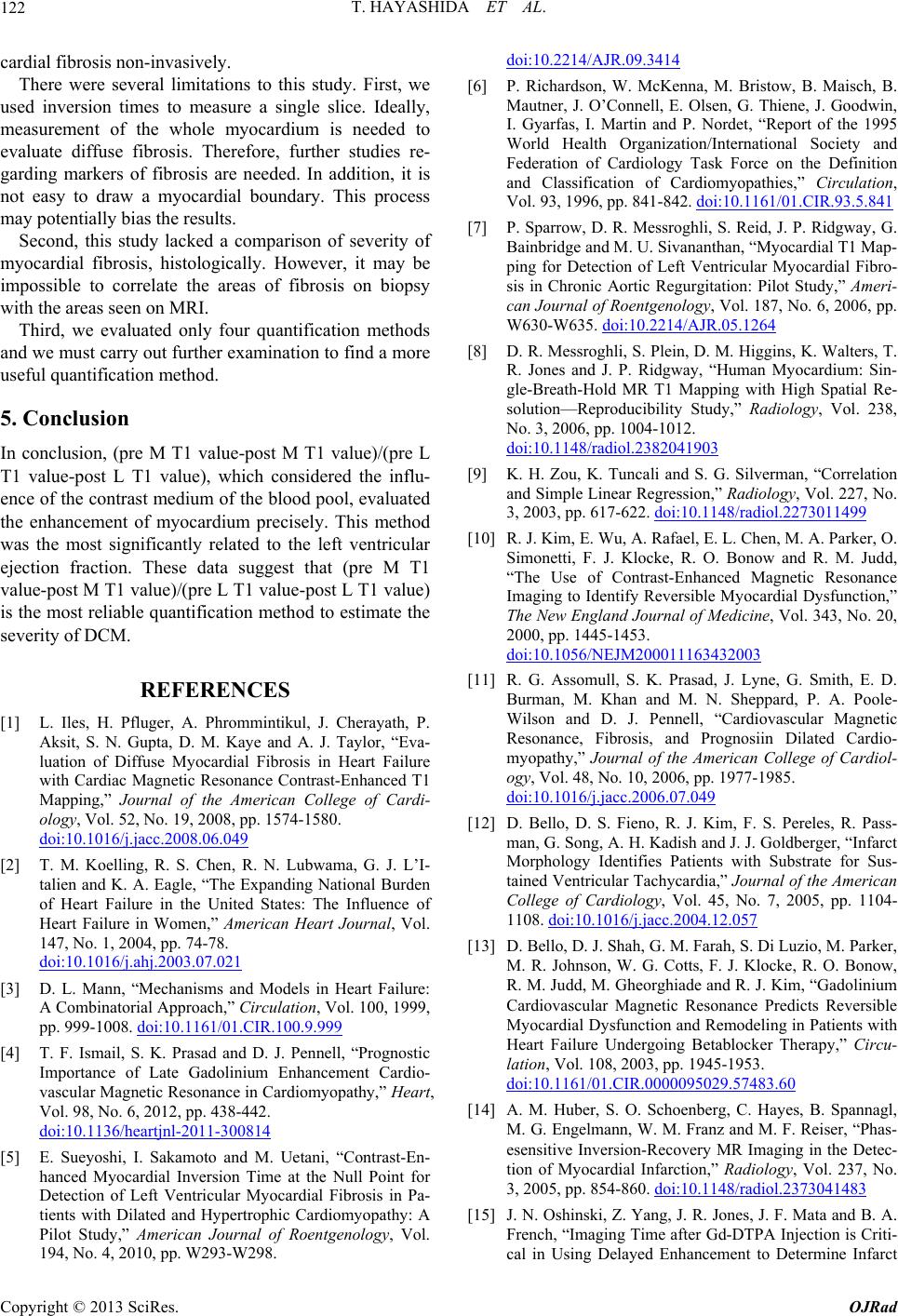
T. HAYASHIDA ET AL.
122
cardial fibrosis non-invasively.
There were several limitations to this study. First, we
used inversion times to measure a single slice. Ideally,
measurement of the whole myocardium is needed to
evaluate diffuse fibrosis. Therefore, further studies re-
garding markers of fibrosis are needed. In addition, it is
not easy to draw a myocardial boundary. This process
may potentially bias the results.
Second, this study lacked a comparison of severity of
myocardial fibrosis, histologically. However, it may be
impossible to correlate the areas of fibrosis on biopsy
with the areas seen on MRI.
Third, we evaluated only four quantification methods
and we must carry out further examination to find a more
useful quantification method.
5. Conclusion
In conclusion, (pre M T1 value-post M T1 value)/(pre L
T1 value-post L T1 value), which considered the influ-
ence of the contrast medium of the blood pool, evaluated
the enhancement of myocardium precisely. This method
was the most significantly related to the left ventricular
ejection fraction. These data suggest that (pre M T1
value-post M T1 value)/(pre L T1 value-post L T1 value)
is the most reliable quantification method to estimate the
severity of DCM.
REFERENCES
[1] L. Iles, H. Pfluger, A. Phrommintikul, J. Cherayath, P.
Aksit, S. N. Gupta, D. M. Kaye and A. J. Taylor, “Eva-
luation of Diffuse Myocardial Fibrosis in Heart Failure
with Cardiac Magnetic Resonance Contrast-Enhanced T1
Mapping,” Journal of the American College of Cardi-
ology, Vol. 52, No. 19, 2008, pp. 1574-1580.
doi:10.1016/j.jacc.2008.06.049
[2] T. M. Koelling, R. S. Chen, R. N. Lubwama, G. J. L’I-
talien and K. A. Eagle, “The Expanding National Burden
of Heart Failure in the United States: The Influence of
Heart Failure in Women,” American Heart Journal, Vol.
147, No. 1, 2004, pp. 74-78.
doi:10.1016/j.ahj.2003.07.021
[3] D. L. Mann, “Mechanisms and Models in Heart Failure:
A Combinatorial Approach,” Circulation, Vol. 100, 1999,
pp. 999-1008. doi:10.1161/01.CIR.100.9.999
[4] T. F. Ismail, S. K. Prasad and D. J. Pennell, “Prognostic
Importance of Late Gadolinium Enhancement Cardio-
vascular Magnetic Resonance in Cardiomyopathy,” Heart,
Vol. 98, No. 6, 2012, pp. 438-442.
doi:10.1136/heartjnl-2011-300814
[5] E. Sueyoshi, I. Sakamoto and M. Uetani, “Contrast-En-
hanced Myocardial Inversion Time at the Null Point for
Detection of Left Ventricular Myocardial Fibrosis in Pa-
tients with Dilated and Hypertrophic Cardiomyopathy: A
Pilot Study,” American Journal of Roentgenology, Vol.
194, No. 4, 2010, pp. W293-W298.
doi:10.2214/AJR.09.3414
[6] P. Richardson, W. McKenna, M. Bristow, B. Maisch, B.
Mautner, J. O’Connell, E. Olsen, G. Thiene, J. Goodwin,
I. Gyarfas, I. Martin and P. Nordet, “Report of the 1995
World Health Organization/International Society and
Federation of Cardiology Task Force on the Definition
and Classification of Cardiomyopathies,” Circulation,
Vol. 93, 1996, pp. 841-842. doi:10.1161/01.CIR.93.5.841
[7] P. Sparrow, D. R. Messroghli, S. Reid, J. P. Ridgway, G.
Bainbridge and M. U. Sivananthan, “Myocardial T1 Map-
ping for Detection of Left Ventricular Myocardial Fibro-
sis in Chronic Aortic Regurgitation: Pilot Study,” Ameri-
can Journal of Roentgenology, Vol. 187, No. 6, 2006, pp.
W630-W635. doi:10.2214/AJR.05.1264
[8] D. R. Messroghli, S. Plein, D. M. Higgins, K. Walters, T.
R. Jones and J. P. Ridgway, “Human Myocardium: Sin-
gle-Breath-Hold MR T1 Mapping with High Spatial Re-
solution—Reproducibility Study,” Radiology, Vol. 238,
No. 3, 2006, pp. 1004-1012.
doi:10.1148/radiol.2382041903
[9] K. H. Zou, K. Tuncali and S. G. Silverman, “Correlation
and Simple Linear Regression,” Radiology, Vol. 227, No.
3, 2003, pp. 617-622. doi:10.1148/radiol.2273011499
[10] R. J. Kim, E. Wu, A. Rafael, E. L. Chen, M. A. Parker, O.
Simonetti, F. J. Klocke, R. O. Bonow and R. M. Judd,
“The Use of Contrast-Enhanced Magnetic Resonance
Imaging to Identify Reversible Myocardial Dysfunction,”
The New England Journal of Medicine, Vol. 343, No. 20,
2000, pp. 1445-1453.
doi:10.1056/NEJM200011163432003
[11] R. G. Assomull, S. K. Prasad, J. Lyne, G. Smith, E. D.
Burman, M. Khan and M. N. Sheppard, P. A. Poole-
Wilson and D. J. Pennell, “Cardiovascular Magnetic
Resonance, Fibrosis, and Prognosiin Dilated Cardio-
myopathy,” Journal of the American College of Cardiol-
ogy, Vol. 48, No. 10, 2006, pp. 1977-1985.
doi:10.1016/j.jacc.2006.07.049
[12] D. Bello, D. S. Fieno, R. J. Kim, F. S. Pereles, R. Pass-
man, G. Song, A. H. Kadish and J. J. Goldberger, “Infarct
Morphology Identifies Patients with Substrate for Sus-
tained Ventricular Tachycardia,” Journal of the American
College of Cardiology, Vol. 45, No. 7, 2005, pp. 1104-
1108. doi:10.1016/j.jacc.2004.12.057
[13] D. Bello, D. J. Shah, G. M. Farah, S. Di Luzio, M. Parker,
M. R. Johnson, W. G. Cotts, F. J. Klocke, R. O. Bonow,
R. M. Judd, M. Gheorghiade and R. J. Kim, “Gadolinium
Cardiovascular Magnetic Resonance Predicts Reversible
Myocardial Dysfunction and Remodeling in Patients with
Heart Failure Undergoing Betablocker Therapy,” Circu-
lation, Vol. 108, 2003, pp. 1945-1953.
doi:10.1161/01.CIR.0000095029.57483.60
[14] A. M. Huber, S. O. Schoenberg, C. Hayes, B. Spannagl,
M. G. Engelmann, W. M. Franz and M. F. Reiser, “Phas-
esensitive Inversion-Recovery MR Imaging in the Detec-
tion of Myocardial Infarction,” Radiology, Vol. 237, No.
3, 2005, pp. 854-860. doi:10.1148/radiol.2373041483
[15] J. N. Oshinski, Z. Yang, J. R. Jones, J. F. Mata and B. A.
French, “Imaging Time after Gd-DTPA Injection is Criti-
cal in Using Delayed Enhancement to Determine Infarct
Copyright © 2013 SciRes. OJRad